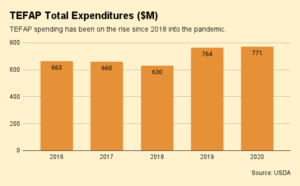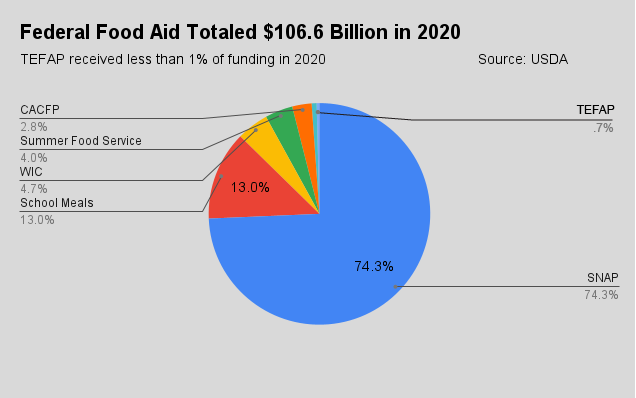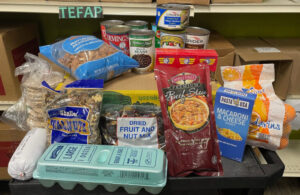Making good on its plan to shut down the Farmers to Families Food Box program and instead focus on existing distribution channels for charitable food, the U.S. Department of Agriculture announced it would invest $1 billion to support food banks.
The aid, announced June 4, includes $500 million to purchase nutritious, domestically produced food for state food bank networks through The Emergency Food Assistance Program. Another $400 million will go toward purchases aimed at strengthening local and regional food systems, and the final $100 million is earmarked for operational costs.
Food bank leaders appreciate the additional funding during a time of continued heightened food insecurity. Lisa Hamler-Fugitt, Executive Director of Ohio Association of Food Banks, hopes the reallocation of resources will be a return to normalcy.

“We could not be more pleased with the announcement,” said Hamler-Fugitt. “The Farmers to Families Food Box Program ended up being problematic in the final months because the food wasn’t there anymore. Some of the food being delivered wasn’t fit for human consumption and disregarded food safety.”
The new program will preserve the intent of the Farmers to Families Food Box program to emphasize fresh produce. TEFAP Fresh Produce boxes will focus on healthy and local produce, and contain three to five pounds of vegetables, three to five pounds of fruit, and at least two locally grown fruits or vegetables. These boxes have an expected shelf life of seven to ten days, once refrigerated.
Historically, TEFAP has received significantly less funding than other food relief programs like the Supplemental Nutrition Assistance Program. However, it is the largest source of federal aid that assists food banks.
TEFAP spending, which includes commodities, administrative expenses, storage and transportation, has risen every year since 2018. The $500 million being dedicated to TEFAP is almost 65% of the total expenditures of TEFAP in 2020.
The USDA signaled that additional investments into the emergency food system will continue throughout 2021 under the Biden Administration’s “Build Back Better” initiative. The current investments compare to the $3 billion the Trump Administration had allocated to move fresh produce from farms directly to struggling individuals under the Farmers to Families Food Box program.
The USDA’s new $100 million increase in food-bank operational support comes as a welcome development. According to Dr. Valerie Hawthorne, Director of Government Relations at North Texas Food Bank, it is difficult to fundraise for operational costs because many donors want to give money directly to food.
 “So many of our partners would love to grow and expand,” said Dr. Hawthorne. “Our local food pantries want to do more, but they just need additional refrigeration, or they need a refrigerated truck, or they need something as simple as a forklift to help build those pantries.”
“So many of our partners would love to grow and expand,” said Dr. Hawthorne. “Our local food pantries want to do more, but they just need additional refrigeration, or they need a refrigerated truck, or they need something as simple as a forklift to help build those pantries.”
The new $400 million commitment to local and regional food systems includes attention to socially disadvantaged farmers. Set-asides during the solicitation process are being made to increase opportunities for women-owned, minority-owned, veteran-owned, and small business owners to become registered vendors with the USDA.
In the press release, Agriculture Secretary Tom Vilsack said that the new budget is the result of lessons learned during the pandemic. The complete $1 billion plan is funded by the American Rescue Plan and the Consolidated Appropriations Act, leveraging $500 million from each.
Claire Babineaux-Fontenot, the CEO of Feeding America, said the organization is looking forward to strengthening the nation’s food bank network to serve people in need. She estimates that the USDA’s announcement “will help put at least 750 million additional meals on the tables of the families we serve.”
The $1 billion in funding comes on the heels of a listening session requesting input from emergency food network experts. Hamler-Fugitt, who provided feedback to the USDA at the event, said she is encouraged by the three-month turnaround of the financial package.
“I have never seen the government respond as quickly as it did now,” she said. — Zachary Smith
Zachary Smith is a freelance reporter and student at the Craig Newmark Graduate School of Journalism at CUNY, where he is specializing in health and data reporting. Currently an intern with Food Bank News, Zachary has recently been published with Everyday Health, Bklyner, and the NYCity News Service.
Like what you’re reading?
Support Food Bank News







